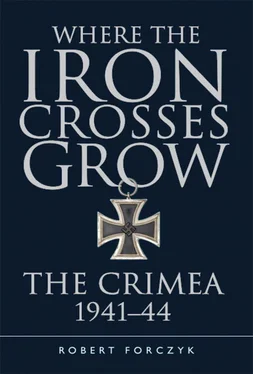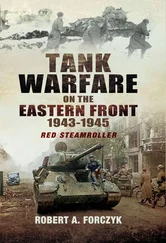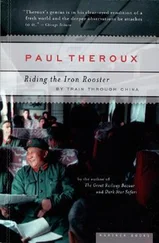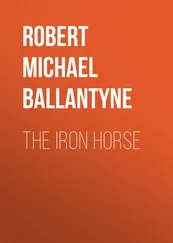Tolbukhin steadily increased the pressure on Festung Sevastopol. On May 1, a major attack was launched by the 2nd Guards Army against the German defenses on the south side of the Bel’bek River. During the fighting, Generalleutnant Friedrich Sixt, commander of the 50. Infanterie-Division, was wounded by artillery fire while inspecting forward defenses on the Ölberg. Sixt was evacuated and Oberst Paul Betz took over the division. Mel’nik’s Coastal Army also succeeded in liberating Balaklava. By this point, AOK 17 had only 64,000 troops left in the Crimea, against over 400,000 Soviet troops. On May 5, Tolbukhin commenced his final offensive at 0930hrs with a massive two-hour barrage by 400 artillery pieces concentrated against the XXXXIX Gebirgs-Korps front in the north. Generalmajor Wolf Hagemann’s 336. Infanterie-Division managed to repulse attacks by five Soviet rifle divisions for the next two days, but Hagemann was badly wounded and was flown out.
While the attacks of the 51st Army focused German attention toward the center of their perimeter around Sevastopol, Mel’nik moved up General-Major Konstantin I. Provalov’s 16th Rifle Corps and a large quantity of artillery into assault positions west of Balaklava. Provalov was an experienced infantry commander who had been awarded the Hero of the Soviet Union for leading a rifle regiment during the battle of Lake Khasan in 1938. On the morning of May 7, Provalov’s 16th Rifle Corps attacked V Armeekorps after a heavy-artillery bombardment and quickly achieved a penetration in the center of the sector held by Generalleutnant Hermann Böhme’s 73. Infanterie-Division. II./Grenadier-Regiment 170 was pummeled by volleys of rocket artillery then overrun by a massive assault spearheaded by the 83rd Naval Infantry Brigade. By evening, Provalov’s troops had penetrated 1,500 yards into the German defense and reached their artillery positions near the village of Karan. V Armeekorps was so badly hurt by this attack that there was no option but to begin withdrawing to its second line of defense. On the same day, Zakharov’s 2nd Guards Army reached the edge of Sevastopol’s Severnaya Bay while Kreizer’s 51st Army pushed back the northern part of the V Armeekorps’ front line and reached the foot of Sapun Mountain with two rifle corps.
Kreizer attacked the German positions around the Sapun Heights with his 63rd Rifle Corps and 1st Guards and 11th Guards Rifle Corps, supported by a strong artillery concentration and considerable close air support. Starting at 0900hrs on May 7, Soviet artillery blasted the top of the heights – held mostly by the 98. and 111. Infanterie-Divisionen – with tube and rocket artillery. At 1030hrs, the Soviet infantry attacked but encountered very strong automatic-weapons and mortar fire from the still-intact German positions. One Soviet rifle-platoon leader, Lieutenant Mikhail Y. Dzigunsky from the 1372nd Rifle Regiment, succeeded in knocking out three German positions, but was killed attempting to knock out a stone machine-gun bunker; he was the first of six men to earn a Hero of the Soviet Union on the Sapun Heights. General-Major Peter K. Koshevoi’s 63rd Rifle Corps attacked all day long, fighting its way through German barbed wire and trenches. By 1800hrs his troops were within 100–200 yards of the crest of the Sapun Heights, but his rifle and artillery units were almost out of ammunition. This was one of those moments where the enemy – not knowing that the attack had actually exhausted itself – made the mistake of pulling back to regroup. Koshevoi’s troops surged forward and overran some of the German positions atop the ridge, and even captured the commander of Grenadier-Regiment 117. Nevertheless, the Soviet foothold was tenuous and Kreizer quickly brought up the 10th Rifle Corps to solidify the Soviet hold on the Sapun Heights. Tolbukhin also ordered the 19th Tank Corps deployed to support the Coastal Army’s attack on May 8. [12] Koshevoi, V gody voennye [ During the War ].
During the night of May 7/8, Allmendinger scraped together Kampfgruppe Marienfeld and Kampfgruppe Faulhaber, supported by the last assault guns, to counterattack the flanks of the Soviet forces atop the Sapun Heights. The German counterattack began around 1000hrs and reached its climax around 1200hrs. Despite regaining some ground, the German counterattack was smothered under a barrage of Soviet artillery and Sturmovik attacks. Once it was clear that the counterattack had failed and that his last reserves were exhausted, Allmendinger reported to Generaloberst Ferdinand Schörner, the commander of Heeresgruppe Südukraine, that Sevastopol could no longer be held. The report was forwarded to the OKH, and at 2300hrs on May 8, Hitler grudgingly authorized the evacuation of AOK 17. One hour later, the Bradul 1 convoy left Sevastopol with 2,887 troops aboard, followed soon thereafter by the Bradul 2 convoy. Soviet artillery bombarded the harbor area, sinking the small German tanker Prodromos and several light craft. Two German battalions from the 50. Infanterie-Division had been isolated by Zakharov’s 2nd Guards Army north of Severnaya Bay, but managed to cross the bay in small boats during the night of May 8/9. Oberst Paul Betz, commander of the 50. Infanterie-Division, personally led a counterattack to link up with these isolated units, which enabled them to escape southward.
On the morning of May 9, Mel’nik’s Coastal Army continued its offensive with the added impetus of the 19th Tank Corps. Up to this point, Soviet armor had played little part in the battle, but now the tanks crashed through the retreating 73. Infanterie-Division and broke up the German front line. Provalov’s 16th Rifle Corps and the tankers pursued these broken fragments back to the Chersonese Peninsula. In anticipation of a last stand, Jaenecke had ensured that the Chersonese Peninsula was well stocked with supplies of food, water, and ammunition. Sevastopol’s last airfield was located here, and Axis ships could still load personnel from several beaches. With the defensive line collapsing, all elements of AOK 17 began retreating to the Chersonese Peninsula in the hope of evacuation. By 1600hrs the last German troops abandoned the ruins of Sevastopol, and Soviet troops from the 51st Army quickly moved in and reached the inner city. During the retreat, Major Willy Marienfeld, commander of Grenadier-Regiment 123, was badly wounded by a shell splinter and was flown out, but he later died of his wounds in Romania. Later that night, Oberst Paul Betz was also killed trying to make his way to the Chersonese Peninsula.
Once it was clear that Sevastopol had been liberated, Tolbukhin realized that he could no longer employ all three armies against the narrowing enemy front, and he gave Mel’nik’s Coastal Army the mission of eliminating the remnants of AOK 17 in the Chersonese Peninsula. The Axis troops retreated to a final line of defense near the old Coastal Battery No. 35, where the peninsula’s neck was only 875 yards wide. Provalov’s 16th Rifle Corps could employ only the 383rd Rifle Division and 32nd Guards Rifle Division, supported by a tank brigade, against this narrow sector. Nevertheless, Tolbukhin’s artillery could strike everywhere on the Chersonese Peninsula, including the airfield. Once Soviet artillery began impacting on the airfield, the Luftwaffe decided to withdraw its last fighters from JG 52 late on May 9, thereby depriving AOK 17 of air cover. Morzik’s transports flew their last missions from Sevastopol on the night of May 9/10, and succeeded in flying out 1,000 wounded from the Chersonese. [13] Carrell, Scorched Earth: The Russo-German War 1943–1944 , p. 471.
After that, the skies over the Chersonese belonged to the VVS.
Despite Hitler’s late endorsement of the evacuation option, the Kriegsmarine and Royal Romanian Navy had prepared as well as they could for this operation. Vizeadmiral Helmuth Brinkmann – who had commanded the heavy cruiser Prinz Eugen during the sortie of the Bismarck in 1941 – was Admiral Schwarzes Meer , commander of all Kriegsmarine forces in the Black Sea. Brinkmann, whose headquarters had moved from Simferopol to Constanta in February 1944, coordinated with the Romanian Navy to ensure that there was more than enough merchant shipping available to evacuate 60,000 troops from the Crimea within a few days. He also put Konteradmiral Otto Schulz, nominally in charge of the Kriegsmarine coastal defenses in the Crimea, in charge of coordinating between AOK 17 and the naval forces involved in the evacuation operation. On the morning of May 9 the first evacuation convoys left from Constanta, with the Patria convoy sailing, and four more later in the day, involving 11 merchant ships and ten MFPs. It normally took a convoy 24 hours to cross the 250 miles from Constanta to Sevastopol, at an average speed of 9 knots. The Patria convoy, escorted by two Romanian destroyers, arrived off the Chersoneses Peninsula around 0200hrs on May 10 and began loading troops onto the merchantmen Teja and Totila (2,760 GRT). Small craft were used to ferry troops from the beaches out to the waiting merchantmen, while the warships kept alert for aerial, surface, and sub-surface threats. Soviet air attacks began at dawn, but did not score any hits, and the convoy set sail for Constanta at 0830hrs. Three German R-Boats escorted the Teja and Totila, which were loaded with 5,000 German and 4,000 Romanian troops. However, at 0930hrs 21 Il-2 Sturmoviks from the 8th Guards Ground Attack Regiment (GshAP) attacked and scored three hits with 100kg bombs on the Totila , which sank in a matter of minutes. The Teja and her escorts continued on, but five hours later 11 A-20G bombers from 13 GDBAP attacked and sank her. The R-Boats managed to rescue about 400 troops, but over 8,000 Axis troops were lost on the Teja and Totila.
Читать дальше












